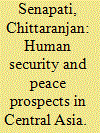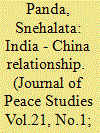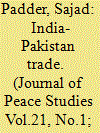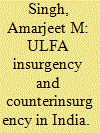|
|
|
Sort Order |
|
|
|
Items / Page
|
|
|
|
|
|
|
| Srl | Item |
| 1 |
ID:
129066


|
|
|
|
|
| Publication |
2014.
|
| Summary/Abstract |
Central Asia has always been a blend of cultures due to its massive migrations and the mixing of peoples coming from outside. In this context this mixture of people in many ways reflected both the best and the worst that each group had to offer. ln the "Great Game" of the Nineteenth century influ-ences from the North and the South played a part in shaping the region'. This unique blend of peoples and cultures are not seen elsewhere in the world (Table 1). To manage this blend of people will always be difficult. So most of the time this bland poses the issues of conflict and insecurity. Be that it is, human security can be an approach to provide security to Central Asian countries. However, in early 1990s, the fall of Berlin Wall (1989), demise of the soviet communism and ascendancy of the neoliberal global regime, altered the international power structure from bipolar to multi-polar world order and this has resulted into the emergence of new security concerns like global terrorism, environmental issues, energy security, food security etc. In the new complicated situation the Central Asian Republics (CARS) have been goaded to rethink the very notion of security from different perspectives.
|
|
|
|
|
|
|
|
|
|
|
|
|
|
|
|
| 2 |
ID:
129065


|
|
|
|
|
| Publication |
2014.
|
| Summary/Abstract |
Strong commercial ties moving in tandem with threats and competition epitomize China's relation with India. The end of the cold war added a new dimension to their relationship because interests of both the countries converged on economic development. Strategies were innovated to promote this objective. But economic relationship has not created an environment of trust to shield their bonding from misperceptions and competition. Ironically the trust deficit is due to antithetical perceptions emerging from the divergence of their interests cloaked in the very process of engagement activated in the 19905. No doubt efforts to strengthen their relationship were set in motion much earlier, yet the reconfiguration of geo politics after the end of the cold war gave it a new twist. It may be divided into three phases; the take off phase followed by a vigorous competitive stage and a slow growth phase. In all these phases the common link is trade detached from outstanding problems. Simultaneously both compete for resources to fuel their growing economies and enhance their influence. In neither case popular opinion gets reflected in the pursuit of foreign policy but, apparently there is difference in popular perceptions and official policy. The nature of the political system in India being more free than China popular opinion gets reflected in the media. Nevertheless the official
position of both the countries is to maintain peace without giving vent to unremitting problems. In the context of geo politics, the divergence and convergence of their interests may be assessed at four levels.
|
|
|
|
|
|
|
|
|
|
|
|
|
|
|
|
| 3 |
ID:
129063


|
|
|
|
|
| Publication |
2014.
|
| Summary/Abstract |
It has a composite culture developed through a historical process wherein the emphasis has been on unity in
diversity. South Asia has been the victim of repeated foreign aggressions. The richness of the region perhaps attracted the aggressors from far and wide. In the successive waves of invasions since the ancient times, the Aryans, the Greeks, the Shakes, the Huns, the Turko-Afgans, the Mughals and others came to the region. In the modern period, the Europeans viz. Portuguese, Dutch, French and the British came to South Asia, though it was the British who finally established their hold in the region. The British invasion was qualitatively different from the earlier ones. Whereas the earlier invaders came, settled down here and got completely assimilated with the indigenous people, the British integrated the region into their empire and ruled it from London. The region was linked with the industrially advanced intemational market in order to exploit its natural resources. South Asian economy and society became subordinated to the imperialist political economy and social development. The region was transformed into a market for the British machine made goods, a source of raw material and foodstuffs, and an important field of capital investment. The entire structure of economic relations between Europe and the South Asia involving trade, finance and technology continuously developed the colonial dependence and underdevelopment of the latter. This new politico-econornic system of subordination, called as colonialism, resulted in the emergence of Europe as a leading
capitalist region while the colonies were reduced to backward.
|
|
|
|
|
|
|
|
|
|
|
|
|
|
|
|
| 4 |
ID:
129067


|
|
|
|
|
| Publication |
2014.
|
| Summary/Abstract |
Assam is a land of different cultural groups. Prior to the advent of the Ahoms, the Mongolian people from Thailand, in the 13th century, different regions of Assam were ruled by different dynasties such as Plas, Koches, Kacharis and Chutiyas. The Ahoms invaded Assam in 1236. The land was named "Asom" by the Ahoms (Assam is its an glicised form). Down the line, they have assimilated into the culture of this land.' The Burmese invaded Assam in 1818 and the Ahorns rulers could not stop them. Thus, the British started interfering in the politics of Assam. Assam came under British rule after the Treaty of Yandabo signed between the Burmese and the British in 1826. In 1838, Assam was amalgamated with Bengal. Assam became a province in 1874. In 1905, Bengal was partitioned; Assam was also amalgamated with eastern part of Bengal. In 1912, Bengal was reunited; again, Assam became a province. After the partition of India
and Pakistan in 1947, Sylhet district of Assam (leaving Karimganj to India) was transferred to Pakistan. Finally, Assam became a state of India in 1950. Down the line, the states of Nagaland, Meghalaya, Mizoram and Arunachal Pradesh were created out of Assam. With a population of about 31 million (Indian Census 2011), Assam is one of the most ethnically and linguistically diverse states of India. Assam has been witnessing different kinds of political movements of varying scale ranging from the movement which sought to establish an independent state of Assam to the formation of new states (provinces) within India? Thus Assam has been the victim of violence unleashed by different insurgent groups in which two of them have been banned by the government for seeking
|
|
|
|
|
|
|
|
|
|
|
|
|
|
|
|
|
|
|
|
|